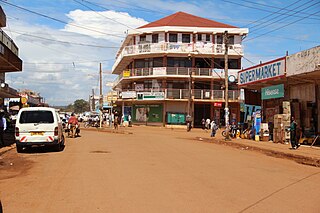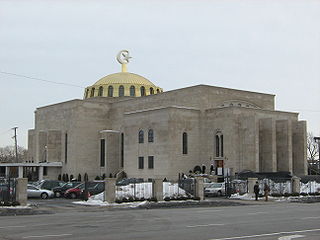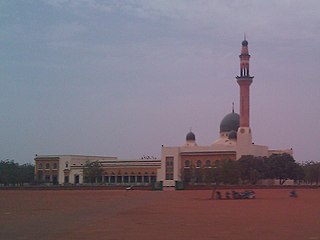
Tripoli is the capital and largest city of Libya, with a population of about 1.183 million people in 2023. It is located in the northwest of Libya on the edge of the desert, on a point of rocky land projecting into the Mediterranean Sea and forming a bay. It includes the port of Tripoli and the country's largest commercial and manufacturing center. It is also the site of the University of Tripoli.

The Second Republic of Uganda existed from 1971 to 1979, when Uganda was ruled by Idi Amin's military dictatorship.
The National Resistance Army (NRA) was a guerilla army and the military wing of the National Resistance Movement (NRM) that fought in the Ugandan Bush War against the government of Milton Obote, and later the government of Tito Okello. NRA was supported by Muammar Gaddafi.

Jinja is a city in the Eastern Region of Uganda, located on the north shore of Lake Victoria.

Islam is the dominant religion in Libya, with 97% of Libyans following Sunni Islam. Article 5 of the Libyan Constitution declared that Islam was the official religion of the state. The post-revolution National Transitional Council has explicitly endeavored to reaffirm Islamic values, enhance appreciation of Islamic culture, elevate the status of Quranic law and, to a considerable degree, emphasize Quranic practice in everyday Libyan life with legal implementation in accordance to Islamic jurisprudence known as sharia. Libya has a small presence of Ahmadis and Shias, primarily consisting of Pakistani immigrants, though unrecognized by the state.

The Uganda–Tanzania War, known in Tanzania as the Kagera War and in Uganda as the 1979 Liberation War, was fought between Uganda and Tanzania from October 1978 until June 1979 and led to the overthrow of Ugandan President Idi Amin. The war was preceded by a deterioration of relations between Uganda and Tanzania following Amin's 1971 overthrow of President Milton Obote, who was close to the President of Tanzania, Julius Nyerere. Over the following years, Amin's regime was destabilised by violent purges, economic problems, and dissatisfaction in the Uganda Army.

Islam is the largest minority religion in Rwanda, practiced by 2% of the total population according to the 2012 census. Virtually all Muslims in Rwanda are Sunni Muslim. Islam was first introduced into Rwanda by Muslim traders from the East Coast of Africa in the 20th century. Since its introduction, Muslims have been a minority in the territory, while Christianity, was introduced to Rwandans during the colonial period in the beginning of the 20th century, and is now the largest religion in the country.

Tanzania is a Christian majority nation, with Islam being the largest minority faith in the country. According to a 2020 estimate by Pew research center, Muslims represent 34.1% of the total population. The faith was introduced by merchants visiting the Swahili coast, as it became connected to a larger maritime trade network dominated by Muslims. This would lead to local conversions and assimilations of foreign Muslims, ultimately causing the eventual formation of several officially Muslim political entities in the region. However, according to the Association of Religion Data Archives (ARDA), 55.3% of the population is Christian, 31.5% is Muslim, 11.3% practices traditional faiths, while 1.9% of the population is non-religious or adheres to other faiths as of 2020. The ARDA estimates that most Tanzanian Muslims are Sunni, with a small Shia minority, as of 2020.

Mosque Maryam, also known as Muhammad Mosque #2 or Temple #2, is the headquarters of the Nation of Islam, located in Chicago, Illinois. It is at 7351 South Stony Island Avenue in the South Shore neighborhood. Louis Farrakhan's headquarters are not on the premises. The building was originally the Saints Constantine and Helen Greek Orthodox Church before it relocated to suburban Palos Hills. Elijah Muhammad, Farrakhan's predecessor as head for NOI, purchased the building in 1972. Muhammad was lent $3 million from Libyan leader Muammar Gaddafi to convert the former church.

Christianity is the largest religion in Tanzania, with a substantial Muslim minority. Smaller populations of Animists, practitioners of other faiths, and religiously unaffiliated people are also present.

The Grand Mosque of Niamey is an Islamic mosque located in Niamey, Niger. It was built in the 1970s. The largest mosque in the city, it is located along Islam Avenue. The building was funded with money from Libya. It features a minaret with 171 steps from top to bottom.

The Uganda National Mosque aka Gaddafi Mosque is a mosque located at Kampala Hill in the Old Kampala area of Kampala, Uganda. It is the largest mosque in East Africa in a country where, as of 2014, 13.7% of the population is Muslim. Completed in 2006, it seats up to 15,000 worshipers and can hold another 1,100 in the gallery, while the terrace will cater for another 3,500. Colonel Muammar Gaddafi of Libya commissioned the mosque as a gift to Uganda, and for the benefit of the Muslim population. Uganda has many mosques but this one is a skyscraper mosque.

Kampala Hill, commonly referred to as Old Kampala, is a hill in the centre of Kampala, Uganda's capital and largest city.
Bashir Saleh Bashir is a former aide of former Libyan leader Muammar Gaddafi of Toubou origin. He was head of the Libyan African Portfolio, a sovereign wealth fund that invested Libya's oil wealth mostly in sub-Saharan Africa, and served as an intermediary between Libya, Africa and France. Bashir was captured after the Battle of Tripoli during the Libyan Civil War, but later escaped. Libya demanded that he be extradited because it was believed he was in France. Bashir spent Libya's oil money solely for the Gaddafi family, buying up hotels, mineral resources and shares in companies, eventually becoming what some Libyan officials and financial experts describe as one of the largest single investors in Africa. Libyan authorities believe that finding him is the key to finding a missing $7 billion in Libyan funds. He is a close associate of French businessman Jean-Yves Ollivier.
The Order of Katonga is the highest military decoration of the Ugandan Honours System. It is a very rare award that recognises its recipients for extraordinary heroism.
The following lists events that happened in 1978 in Libya.
The Battle of Jinja was a battle of the Uganda–Tanzania War that took place on 22 April 1979 near and in the city of Jinja, Uganda between Tanzanian and allied Uganda National Liberation Front forces on the one hand, and Ugandan troops loyal to Idi Amin on the other. The Tanzanians and the UNLF men met slight resistance and captured Owen Falls Dam and the town of Jinja.
Hussein Mohammed was an Ugandan military officer who served as commander of the Uganda Army's Eagle Colonel Gaddafi Battalion, stationed in Jinja, during the rule of Idi Amin.
Foreign support played an important role for Uganda during the Uganda–Tanzania War of 1978–1979. Before this conflict, the Second Republic of Uganda under President Idi Amin had generally strained international relations. Accordingly, only a few states as well as non-state allies provided Uganda with substantial military support during the war, most importantly Libya under Muammar Gaddafi and the Palestine Liberation Organisation. The intervention of these two parties was regarded as crucial for Amin's ability to stay in power during the later stages of the war, even though they did not prevent Uganda's eventual defeat. However, there were many claims about other states and groups in Africa, the Arab world, Europe, and Asia covertly supplying Amin with materiel, soldiers, and money, although most of these remain unverifiable.











